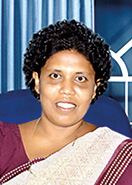A principal’s effort to retell a great story
As an old girl and past principal of Musaeus College, N.K. Pilapitiya is the perfect choice to author a book about the school she loves with all her heart. And so it was with great enthusiasm that she sat down to write ‘Tale of a Mud Hut: the Musaeus Saga’, the retelling of Musaeus’ 120-year-old legacy.
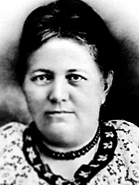 |
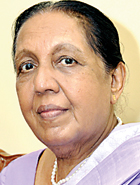 |
| Amazing dedication: Marie Musaeus Higgins (Left) and Mrs. N.K. Pilapitiya | |
It was certainly a Herculean task to take on. Imagine summarising over a century’s worth of tales into a small volume of 232 pages. Factor in the time period most of the volume concerns with, that of the late 19th and early 20th centuries, and you have an assignment most would run miles from!
And run figurative miles away they did. When Mrs. Pilapitiya brought up the concept of the book during her years as Principal (1995-2009), many would shy away. She recalls the times at committee meetings she would bring up the idea for a book that would retell the story of Musaeus. “Everyone would say yes, but it never got off the ground!” This combined with her hectic workload as principal of one of Colombo’s leading girls’ schools meant the actual writing of the book never came to fruition till about three years ago.
Once she had retired in 2009, she found herself much less occupied, and decided that then was the perfect time to embark on what had been a long-dreamt of mission. Helped on by good friend and the school librarian of that time, Kanthi Fernando, the book made slow but steady progress.
“The first two chapters dealt a lot with history, not necessarily that of Musaeus,” says Mrs. Pilapitiya. “So there was a lot of researching that needed to be done.” The author discusses Sri Lanka’s education system from times of yore, through colonization and right up to the dominance of the British educational reforms. This section also details the resurgence of education founded on Buddhism, as opposed to the missionary schools that only offered children the opportunity for a Christian education.
The book itself is informative, well written and a pleasure to read. The author breaks up the volume in chronological order, starting from early education, moving onto the events that led to the main founder of the school, Marie Musaeus Higgins to embark on her mission to Sri Lanka; subsequently gathering the collective support of her co-founders to establish Musaeus College for Buddhist girls.
“What strikes me most about the school’s history is the amazing dedication and absolute commitment of the school’s founders,” says Mrs. Pilapitiya. “Mrs. Higgins had just been widowed, and for her to give up the luxuries and comforts of her homeland to move to a country she had never been to, just for the sake of furthering education-that’s remarkable.”
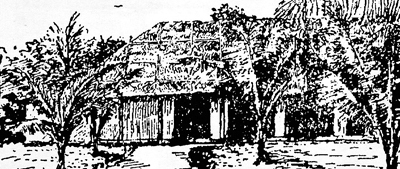
The beginnings: A house of mud and wattle
She quotes directly from a book written by Higgins, titled ‘Roots of Musaeus’ with regard to her motivation for moving to Sri Lanka. “…the great desire to devote myself to the cause of humanity in the especial line of education came to me..”.
The author lends great credibility to her work by frequently citing sources and through the use of carefully compiled pictures from the past. News articles, postcards from Mrs. Higgins to her students, portraits and sketches of that time, obituaries, photographs of significant events and the many places associated with Musaeus are included and lend credence to Mrs. Pilapitiya’s writing.
Her sources for these samples and the story are great and many. Being niece to one of the early pupils of Musaeus, Mildred Madana, was a significant contributing factor to her extensive knowledge about the school’s early years. Helped on by past principals and present, along with the past pupils, relatives of the first 12 pupils, and her family and friends, she completed the book within the span of three years.
The book would have been an impossibility without Kanthi Fernando, whom Mrs. Pilapitiya fondly refers to as “the pillar to my work”. Mrs. Fernando, in her capacity of Head Librarian at Musaeus (till 2010, when she retired), ensured that the author had plenty of sources to refer from, and would assist Mrs. Pilapitiya in sorting through the school archives. And of course, “living only 100 rupees away from each other by tuk helps!,” interjects a laughing Mrs. Fernando.
Extract from the book
Marie Musaeus Higgins, Founder Principal of Musaeus College, was born on 19th May 1855 in Germany, in Wismar, in the city of Newstead near Macklenburg, to a family of six children. Her father was Theodore Musaeus, a Chief Justice. Caroline Musaeus was her mother. Born to an affluent family, she was fortunate in that her parents provided her with the best in education. ………………..
……..With all her success she did not wish to confine herself to her homeland. She travelled to the USA to join her elder brother who was the Head of a School in Washington. It was here that she blossomed out using her many accomplishments and talents. Marie taught French, Greek and Music in this school all the while furthering her studies. Frau Professor Marie Musaeus in spite of her qualifications joined the US Postal Department as Translator and worked for 7 years.
There she met Anton Higgins who was an army engineer and a member of the Theosophical Society, whom she married. They had no children and their married life of 3 years ended when he succumbed to a brief illness.
Grieving over the death of her husband, Marie pondered over an advertisement appearing in the Theosophical Magazine, “The Path” published by Colonel Henry Steel Olcott and Peter de Abrew calling for an European lady to take up the position of Principal in a newly established Buddhist Girls School. She applied without hesitation, and the reply from Colonel Olcott was equally prompt requesting her to travel immediately.
The following quotation “Roots of Musaeus” by Higgins gives the details “Fourteen years ago when I was living in Washington D.C. where I held a position under the Government for 7 years, the great desire to devote myself to the cause of humanity in the especial line of education came to me. Then it was that I saw in a magazine an appeal from the island of Ceylon, from a number of Sinhalese Buddhist mothers who had awakened to the great need of education for the girls of Ceylon, imploring some competent unprejudiced woman to come to them to undertake the education of their daughters. The appeal furthermore stated that no one seemed to care for those who loved their own religion so much, as to be disinclined to send their daughters to mission sectarian schools, where they would learn to despise their own religion and to disregard its precepts. My heart went out to them at once and I felt that this work of education and civilization was my mission for life. Through the study of Buddhism, I knew it would not be against my conscience not to disturb them in their Religion and so I answered at once to the appeal and wrote to the writer of it, an educated Sinhalese gentleman, that I would come to Ceylon and undertake to be a mother to the daughters of Lanka.
A young lady in Australia had read the same appeal, and made a decision similar to my own. Having a shorter journey to reach Ceylon, she arrived there before me. Unfortunately, a few days after her arrival she was found drowned in the well of the school compound. The mystery of this misfortune has never been solved.
Of course, I was advised not to go to Ceylon but my mind was made up and I started at once on my voyage half way round the world. When I arrived on the 15th November 1889, I was greeted with great enthusiasm by the Buddhists and was conducted to the hired School house.”
The name of the school was Sanghamitta Vidyalaya. It was situated at Tichbourne Passage, Maradana.
After the unfortunate death of Kate Picket, the former Principal, there was great confusion and disorder. However Peter de Abrew soon stood by her side, strong and supportive. A meeting of the Women’s Educational Society was held and Marie Musaeus Higgins was elected President.
Higgins had to face many difficulties. ……………
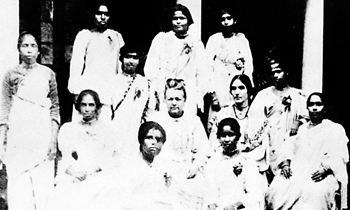
The first 12 students ;Amarawathie de Silva, Leonara de Zoysa, Elsie de Silva, Jane de Zoysa, Adlin de Silva , Leela Gunasinghe, Sophaya De Silva, Connie Batuwantudawe, Kittie Mendis, Lucy de Abrew, Agnes Helen Don Philip Wijewardene and Somie Jayaweera Bandara with Principal Marie Musaeus Higgins
…….In the meantime an elderly gentleman from Australia, Dr. W.A English arrived with his daughter Alice and her friend, Miss Allison and joined Higgins in her work. However, the struggle went on for two years. This had an impact on her health and she decided to resign from the post of Principal at Sanghamitta Vidyalaya, and start a school of her own on a different and better basis.
It was at this juncture that Peter de Abrew stepped in. He had indicated to his father, Mr. William de Abrew, a philanthropist, that he wished to start a school for the education of Buddhist girls. William de Abrew very willingly donated a “beautiful piece of land” in Cinnamon Gardens, one of the finest and healthiest suburbs of Colombo, he also furnished all the timber needed. Initially a house of “mud and wattle” was built and Marie Musaeus Higgins moved into the “Mud palace” in February 1891 with 12 girls and her American friends. It was here that Musaeus School was founded. It was named “Musaeus Boarding School” after her father. This was in 1891……………
….The early years were not easy but Higgins found help from unexpected quarters and there was always a band of co-workers. One such instance was the arrival of Mr. Wilton Hack, a Theosophist en route to Australia from London. He stopped over in Ceylon as he wished to meet Higgins about whose work he had already heard. He was amazed at the conditions under which she worked and at the same time was impressed by the happy faces of the students, and what she was achieving. The girls busied themselves with a delicious meal and also gave a short entertainment.
Before leaving he promised the students he would visit them again on his return home and before long they would have a two storied building.
After a few months he returned to fulfill his promise. The building came up in 1893, and the School was registered with the Government as “Musaeus Buddhist Girls College”.















